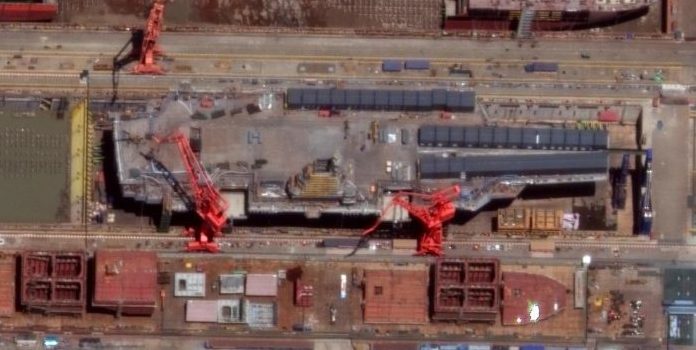(Headline USA) China’s most advanced aircraft carrier to date appears to be nearing completion, satellite photos showed Friday, as experts suggested the vessel could be launched soon.
The newly developed Type 003 carrier has been under construction at the Jiangnan Shipyard northeast of Shanghai since 2018. Satellite images taken by Planet Labs PBC on May 31 suggest work on the vessel is close to done.
The launch has been long anticipated, and constitutes what the Center for Strategic and International Studies think tank called a “seminal moment in China’s ongoing modernization efforts and a symbol of the country’s growing military might.”
CSIS noted in a report that China often pairs military milestones with existing holidays and anniversaries. It suggested that the vessel could be launched as soon as Friday to coincide with the national Dragon Boat Festival, as well as the 157th anniversary of the founding of the Jiangnan Shipyard.
In the satellite images, the carrier’s deck can be clearly seen. In an image taken Tuesday through wispy clouds, equipment behind the carrier appears to have been removed, a step toward flooding the entire drydock and floating the vessel. Pictures earlier this month showed work ongoing.
Though no launch was announced, the state-run Global Times newspaper on Tuesday ran a story quoting reports that it “could be launched soon.”
It added that the Chinese navy in April had released a promotional video on the country’s carrier program “in which it implied that the country’s third aircraft carrier will be officially revealed soon.”
Though the U.S. Department of Defense estimates that the carrier won’t be fully operational until 2024, first needing to undergo extensive sea trials, the carrier is China’s most advanced yet. As with its space program, China has proceeded extremely cautiously in the development of aircraft carriers, seeking to apply only technologies that have been tested and perfected.
Its development is part of a broader modernization of China’s military as it seeks to extend its influence in the region. China already has the largest navy in the world in terms of numbers of ships, but not near the capabilities of the U.S. Navy.
Among other assets, the U.S. Navy remains the world’s leader in aircraft carriers, with its forces able to muster 11 nuclear-powered vessels. The Navy also has nine amphibious assault ships, which can carry helicopters and vertical-takeoff fighter jets as well.
The expected launch of the new Chinese carrier comes as the U.S. has been increasing its focus on the region, including the South China Sea. The vast maritime region has been tense because six governments claim all or part of the strategically vital waterway, through which an estimated $5 trillion in global trade travels each year and which holds rich but fast declining fishing stocks and significant undersea oil and gas deposits.
In addition to being the largest of its three carriers, the new Type 003 class is fitted with a catapult launch system that will “enable it to support additional fighter aircraft, fixed-wing early-warning aircraft, and more rapid flight operations and thus extend the reach and effectiveness of its carrier-based strike aircraft,” the U.S. Defense Department said in its annual report to Congress on China’s military in November.
“In particular, the PRC’s (People’s Republic of China’s) aircraft carriers and planned follow-on carriers, once operational, will extend air defense coverage beyond the range of coastal and shipboard missile systems and will enable task group operations at increasingly longer ranges,” the Defense Department said, adding that the Chinese navy’s “emerging requirement for sea-based land-attack systems will also enhance the PRC’s ability to project power.”
China’s existing carriers weigh in at about half the size of the U.S. Nimitz class flattops and displace about 100,000 tons fully loaded.
Experts from the Washington-based CSIS, which has been monitoring the construction for years, said in an analysis Thursday of different satellite images by Maxar Technologies, also taken Tuesday, that a smaller vessel had been moved out of the carrier’s way, and that water now partially fills some of the dry dock.
Adapted from reporting by the Associated Press

